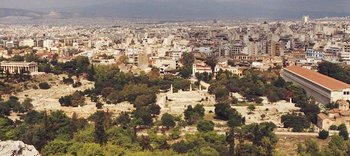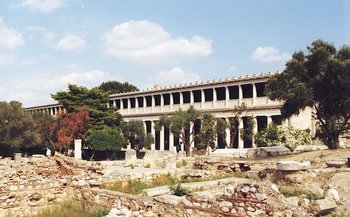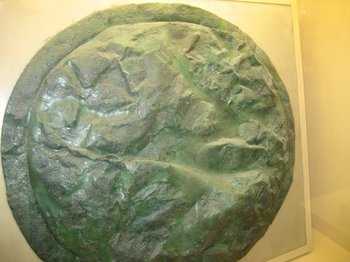Socrates was a gadfly on the rump of Athens, usually in the Agora.
Entrance to the Ancient Agora is included in the twelve Euro price for the Acropolis. So we did that, too, on another day. “Agora?” A market place not all that different from the flea market in nearby Monastiraki Square (Monkey Square to me) Here it is from the slope of the Acropolis. The red roof is the Stoa of Attalos (see below) and to the left is a well preserved Roman temple. In between these two is the Greek Agora.

A view of the Stoa. To the left is the Speaker’s Corner. It is unlikely Socrates ever stepped up there to speak but it is certain he stood there and listened to others speak and then tried to argue with them.

Lots of nice photographs here that are better than any I took. http://www.athensinfoguide.com/photoalbum/ancientagora/ancientagoraindex.htm
And an explanation here.
http://www.athensinfoguide.com/wtsagora.htm
and here
http://www.greeklandscapes.com/greece/athens_agora.html
http://odysseus.culture.gr/h/3/eh351.jsp?obj_id=2485
It was here that Socrates proved to be a gadfly on the rump of Athens. Pestering people. Today it includes the Stoa of Attalos, which was dug up in 1859 and rebuilt in 1955 or so. Think of it as mall. Though this is Roman it was build n the foundation of a still earlier Greek stoa or porch.
The Stoa now houses a museum which counts among its treasures a Spartan shield taken at Pylos. This was a crushing victory of the Athenians over Sparta, one achieved with a lot of effort and very little blood shed, the kind of victory every soldier likes. It was all the sweeter for being close to Sparta and far from Athens. The tactical story is detailed in Thucydides. The end game was that a group of several hundred Spartans were trapped on an isthmus of land by sea borne Athenians who then starved them into submission. Yes, of course, the Spartan got all 300-like and tried to fight their way out. But here we have to correct the “300” http://www.imdb.com/title/tt0416449/
which is wrong in just about every respect. The average Spartan hoplite (soldier) was about 5’ 2” or 157 centimetres. Scratch those hulking brutes so loved of film makers. Even cute little David Wenham is way too big. The Spartan had only one kind of soldier. No cavalry. No archers. No slingers. Heavily armoured infantry men. Heavily armoured. Each man wore armour on the front and back of the ankles. Achilles taught them that. Grieves on the shins. A breast plate with metallic shoulder pads. Under all of this dried leather and coarse fibers. The armour was not kevlar but bronze. The total kit would have weighted about sixty pounds, say 27 kilograms. That is the armour. Then comes the weapon, a short sword and a shield. The shield is large enough to shelter the whole man from arrows: big, in other words. It has to be strong enough to withstand the repeated blows of axes, spears, and swords: thick and reinforced with oak, heavy in other words. The sword and the shield add another 10-12 kilograms to the load. I was disappointed to find that the War Museum did not have much from the classical period, but a great deal about the ancient enemy (Turkey).
The Spartans at Pylos could not fight their way out because the Athenians assailed them with rocks from slingers, arrows from archers, harried them on the flank with cavalry, littered their path with obstacles and created various traps and blinds on the narrow strip of land. They also launched flaming missiles at them from ships. The Spartans were like the Persians at Marathon, unable to deploy their superior material strength in the small space. Muscle-bound in other words. A Spartan wearing and carrying forty plus kilograms of armour and weapons is slow in all senses. A slinger who strikes him from the back is lethal as the armour is all on the front except for the ankles, so those dastardly slingers would scamper about hiding in a most ungentlemanly fashion behind trees and sling a rock at them. A horseman could ride down a hoplite with ease. Etc.
Here is the shield I saw.

True, Spartans thus encumbered were a fearsome fighting machine because they had an iron discipline to go with the weight they carried. They stayed in formation no matter what. They were unsurpassed at going straight ahead. Any enemy stupid enough to stand in the way was pulverized. Any one who attacked a Spartan line head-on was shattered. But that is all they were good for. So in the twenty-seven years of the Peloponnesian War there were only two hoplite battles. Most of the time Sparta’s opponents avoided head-to-head confrontations just as did the Athenians at Pylos.
The other dopey thing about Sparta was its impossibly narrow definition of a Spartan. Whereas Athens threw the door open to anyone who wanted to live there, provided they did naval service. Thy name is multi-culturalism. Sparta kicked out its own to achieve some kind of ever greater pre-Nazi racial purity. Its total number of male citizens probably never exceeded a thousand at the most. See http://en.wikipedia.org/wiki/Spartiate
So when the Athenians trapped 420 Spartan warriors at Pylos they had one very great prize, all the more so when it turned out that 120 of them were Spartiate. The Spartiate are perhaps analogous to the nobility, tracing lineage back generations. To get those 120 back, Sparta asked for peace on Athens’s terms. Athens was not generous in victory. No Abraham Lincoln to speak for reconciliation.
By the way, Socrates carried a spear in this war.
